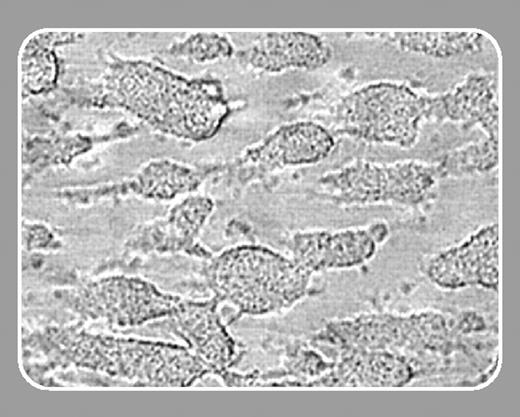Endothelium-derived nitric oxide (NO) or pharmacologic drugs such as the antihypertensive, NO-releasing agent sodium nitroprusside (SNP) and the cyclic guanosine monophosphate (cGMP)–phosphodiesterase type 5 inhibiting, penile erection-stimulating agent sildenafil (Viagra) increase the levels of the second messenger cGMP in cells. Elevation of cGMP induced by these substances has been recognized to cause relaxation of smooth muscle cells and inhibition of platelets. A major mechanism in platelets is the activation of the cGMP-dependent protein kinase (cGK) type I and the subsequent phosphorylation of specific target proteins such as the vasodilator-stimulated phosphoprotein (VASP). However, early studies in the 1970s showed that platelet stimuli such as adenosine diphosphate (ADP), thromboxane receptor agonists, and collagen also increased platelet cGMP levels; cGMP elevation required stirring and depended hence on platelet aggregation.1 A recent study based on experiments with cell lines, pharmacologic cGK-activating and inhibiting agents, and cGK type I (cGKI)–deficient mice proposed a stimulatory role of cGMP and cGK in von Willebrand factor (VWF)– and thrombin-induced platelet activation.2 The authors showed that cGK activation after glycoprotein Ib (GPIb) stimulation leads to p42/44 mitogen-activated protein (MAP) kinase (extracellular signal-related kinase [ERK]) phosphorylation and activation, which was essential for integrin αIIbβ3 activation. They also reported that cGK activators (cGMP analogs, NO donors) increased ERK phosphorylation.3 This provocative proposal of a stimulatory signaling pathway of cGK to MAP kinases and the fibrinogen receptor in platelets has now been challenged by 2 studies published in this issue, putting the old view back in place.
The study by Gambaryan and colleagues (page 2593) shows that cGMP analogs inhibit human platelet activation independent of their effect on cGK. Using a series of cGMP analogs, which activate and putatively inhibit cGK in platelets, they show that all of these agents inhibited platelet activation; even the platelet inhibitory effect of established cGMP analogs that activate cGK was unrelated to the phosphorylation of the cGK-substrate VASP. Furthermore, the authors could not confirm the findings that cGK activators such as NO donors or cGMP analogs induced ERK phosphorylation or promoted platelet activation (assessed by P-selectin expression). This study is further supported by results of the second study by Marshall and colleagues (page 2601), which found that cGK inhibitors reduced thrombin-induced aggregation of platelets obtained from wild-type and cGK-deficient mice to the same degree.
In the study by Marshall et al results are presented that further contradict the studies of Li et al.2,3 The authors demonstrate that agents that elevate cGMP (NO donors and sildenafil) inhibited, rather than promoted, VWF- and thrombin-mediated platelet aggregation in vitro and thrombus formation in a rabbit model in vivo. By using pharmacologic inhibitors, the authors show that VWF/GPIb-stimulated platelet aggregation is not mediated by MAP kinases but by Src kinases. They were also unable to observe MAP kinase phosphorylation after increasing intracellular cGMP levels in platelets. Furthermore, they find that the dose-response curve to thrombin was similar in wild-type and cGKI-/- platelets. Together, the 2 studies published in this issue contradict the studies by Li et al proposing that cGK activation promotes VWF- and thrombin-induced platelet aggregation, and they reinstate the widely held view that cGMP and cGK mediate platelet inhibition rather than platelet stimulation.
What else may be the function of the cGMP increase observed after platelet stimulation? It has been reported that cGMP elevation induced by endogenous NO in stimulated platelets might limit aggregation.4-6 Thus, inhibition of the endothelial NO synthase (eNOS) present in platelets reduced cGMP levels and enhanced aggregation in vitro, and caused a reduction in bleeding time in vivo; conversely, stimulation of eNOS with l-arginine increased the platelet cGMP content and diminished aggregation.4-6 It was further observed that NO production started after maximal aggregation, and experiments using eNOS inhibitors and knock-out mice showed that NO released from aggregated platelets inhibited mainly recruitment of additional platelets to a growing thrombus rather than reducing primary platelet aggregation.5,6
However, the enigma of the cGMP increase in activated platelets is not completely resolved, since during the first minutes of platelet aggregation cGMP is apparently released from the cell,7 and might consequently not be able to efficiently activate intracellular cGKI. This cGMP efflux could explain the normal aggregation responses of cGKI-deficient platelets induced by thrombin and collagen (Marshall et al and Massberg et al8 ) and suggests that targets of cGMP other than cGKI mediate the effect of cGMP elevation in activated platelets.



